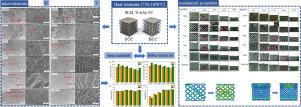当前位置:
X-MOL 学术
›
Int. J. Mech. Sci.
›
论文详情
Our official English website, www.x-mol.net, welcomes your feedback! (Note: you will need to create a separate account there.)
Effects of heat treatment on microstructure and mechanical properties of selective laser melted Ti-6Al-4V lattice materials
International Journal of Mechanical Sciences ( IF 7.3 ) Pub Date : 2021-01-01 , DOI: 10.1016/j.ijmecsci.2020.106042 Nan Jin , Zhenyu Yan , Yangwei Wang , Huanwu Cheng , Hongmei Zhang
International Journal of Mechanical Sciences ( IF 7.3 ) Pub Date : 2021-01-01 , DOI: 10.1016/j.ijmecsci.2020.106042 Nan Jin , Zhenyu Yan , Yangwei Wang , Huanwu Cheng , Hongmei Zhang

|
Abstract Titanium alloy lattice materials fabricated by selective laser melting (SLM) have shown great potential in many engineering applications related to energy absorption. The mechanical behavior of the titanium alloy is dependent on its microstructure that can be improved by heat treatment. However, little attention has been paid to the effects of heat treatment on the lattice materials, and the relationship between the mechanical properties of the base material and the lattice structure is unclear. In this study, based on the body-centered cubic (BCC) and face-centered cubic (FCC) titanium lattice material fabricated by SLM, different heat treatments (750-1050°C, including hot isostatic pressing) were conducted to study the relationship between the microstructure and mechanical properties of the base material and the mechanical properties of the lattice materials. The results show that bending-dominated structure BCC is more sensitive to the heat treatment conditions than stretching-dominated structure FCC. The better heat treatment temperature for BCC and FCC are 920°C and 750°C respectively. Moreover, a numerical simulation model was established to show the relationship between the mechanical properties of the base material and the lattice material. These results are significant for the design and application of titanium lattice materials.
中文翻译:

热处理对选择性激光熔化Ti-6Al-4V晶格材料组织和力学性能的影响
摘要 通过选择性激光熔化 (SLM) 制备的钛合金晶格材料在许多与能量吸收相关的工程应用中显示出巨大的潜力。钛合金的机械性能取决于可以通过热处理改善的微观结构。然而,很少有人关注热处理对晶格材料的影响,基材的力学性能与晶格结构之间的关系尚不清楚。在本研究中,基于 SLM 制备的体心立方 (BCC) 和面心立方 (FCC) 钛晶格材料,不同热处理(750-1050°C,包括热等静压),研究了基体材料的显微组织和力学性能与晶格材料力学性能之间的关系。结果表明,弯曲主导结构 BCC 对热处理条件比拉伸主导结构 FCC 更敏感。BCC和FCC的较好热处理温度分别为920℃和750℃。此外,还建立了数值模拟模型,显示了基体材料与晶格材料力学性能之间的关系。这些结果对钛晶格材料的设计和应用具有重要意义。BCC 和 FCC 的较好热处理温度分别为 920°C 和 750°C。此外,还建立了数值模拟模型,显示了基体材料与晶格材料力学性能之间的关系。这些结果对钛晶格材料的设计和应用具有重要意义。BCC 和 FCC 的较好热处理温度分别为 920°C 和 750°C。此外,还建立了数值模拟模型,显示了基体材料与晶格材料力学性能之间的关系。这些结果对钛晶格材料的设计和应用具有重要意义。
更新日期:2021-01-01
中文翻译:

热处理对选择性激光熔化Ti-6Al-4V晶格材料组织和力学性能的影响
摘要 通过选择性激光熔化 (SLM) 制备的钛合金晶格材料在许多与能量吸收相关的工程应用中显示出巨大的潜力。钛合金的机械性能取决于可以通过热处理改善的微观结构。然而,很少有人关注热处理对晶格材料的影响,基材的力学性能与晶格结构之间的关系尚不清楚。在本研究中,基于 SLM 制备的体心立方 (BCC) 和面心立方 (FCC) 钛晶格材料,不同热处理(750-1050°C,包括热等静压),研究了基体材料的显微组织和力学性能与晶格材料力学性能之间的关系。结果表明,弯曲主导结构 BCC 对热处理条件比拉伸主导结构 FCC 更敏感。BCC和FCC的较好热处理温度分别为920℃和750℃。此外,还建立了数值模拟模型,显示了基体材料与晶格材料力学性能之间的关系。这些结果对钛晶格材料的设计和应用具有重要意义。BCC 和 FCC 的较好热处理温度分别为 920°C 和 750°C。此外,还建立了数值模拟模型,显示了基体材料与晶格材料力学性能之间的关系。这些结果对钛晶格材料的设计和应用具有重要意义。BCC 和 FCC 的较好热处理温度分别为 920°C 和 750°C。此外,还建立了数值模拟模型,显示了基体材料与晶格材料力学性能之间的关系。这些结果对钛晶格材料的设计和应用具有重要意义。



























 京公网安备 11010802027423号
京公网安备 11010802027423号